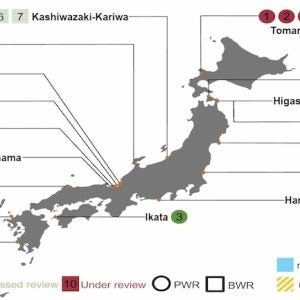If the aim of Denmark’s wind energy industry was to prove the durability and reliability of large wind farms on remote sites in the most violent and unpredictable of conditions – it could hardly have chosen a more hostile site than Horns Rev.
Located in an area of water extending 14 to 20 km into the North Sea west of Jutland, the site’s wind conditions are fierce, freezing and variable with an average speed of 9.7 m/s. It is where the highest wind speed (58.3 m/s) ever recorded in Denmark occurred. Violent wave conditions are exacerbated by high ocean currents in relatively shallow waters – an eight metre high swell is not unusual.
Nevertheless, owing to good logistical planning, installation of the eighty 2 MW Vestas V80 wind turbines during the summer of 2002 went well. It was during 2003 that the first evidence of susceptibility began to show.
Key technical characteristics of the project were described in the October 2002 issue of Modern Power Systems. The original project construction costs amounted to some r270m of which interconnection to the grid cost some r40 million. Output of over 600 GWh/y was expected. The operators opted for an offshore platform mounted 34/150 kV transformer and switchgear to feed the land cable.
First power
The first unit had been commissioned and first power delivered to the national grid on 29 July 2002 at 8.20 pm. The first of five groups of 16 turbines was due to be commissioned in July 2002, but damage to the main power cable caused some delay when a 150 m long section of new cable had to be welded in. All 80 turbines were due to be in operation by the end of 2002 and they had in fact been started at least by that date. By February 2003 all turbines had commenced their contractual test period.
Problems start
However it seems that during the next one and a half years of operation, there was only one half hour period in which all 80 machines were operating together . It has been observed that there had been some 75 000 maintenance trips in one and a half years, that is, two per turbine per day. Every time they needed another wrench or a new circuit board they had to call another helicopter. The maintenance staff had been accustomed to using service vans.
Operator Elsam had been under no illusions about the variety of challenges faced by the Horns Rev project. Although the turbine technology was proven it was a scale-up of the two offshore Vestas V- 66 units which have served well as technology workhorses at Blyth in the UK, where the famous video clips of waves breaking over the tops of the nacelles were recorded. Moreover, the site conditions were covering new ground, and operation of a high voltage grid for a wind farm off this size would constitute a major challenge. Liaison with navigation and aviation authorities was a further important consideration.
Failures at Horns Rev
Technical failures of the transformers began in August 2003. By the winter some 20-30% of the transformers had been affected, owing to a combination of factors – manufacturing problems, weather conditions offshore, possibly salt in the air affecting the transformers, and after effects from the transformers’ being stored onshore.
With a fifth of the turbines affected within the first year, Elsam judged that eventually all the transformers would develop faults and decided to replace them in a single operation. Along with transformer problems there were also generator failures, although fewer than with the transformers, but again, mainly because of apparent manufacturing faults, Elsam decided to replace them all.
Vestas decided that a root cause was a manufacturing problem in the components, first tracked down during 2003. Company director Sven Sigaard stated: “It’s a question of the transformers – they are not insulated correctly and the faults in the insulation cause shorts.” Discussing the generators, he said “a number of the generators are part of a bad series. The windings are not functioning.” Corrosion due to salt ingress was another problem. Component suppliers insist that it was ‘environmental’ in origin, but it has caused far more corrosion damage at this site than anywhere else. In any event the pressure was then on Vestas and Elsam to complete an ambitious investigation, rebuilding and recommissioning programme by the end of the summer weather ‘window’.
Fixing the problem
Elsam, Vestas, and ABB, who supplied the transformers and generators, analysed the situation. Alleged salt water ingress into generators and unit transformers along with what appeared to be manufacturing faults led to the decision in the spring of 2004 to return the complete nacelles to the works at Ringkøbing and Lem for dismantling, followed by replacement of the transformers and some of the generators. For many reasons, mainly the availability of vessels, and favourable weather forecasts covering the period until likely re-installation, Elsam had decided to do the work ashore. Because it had become apparent that all the nacelles were likely to develop faults, and because of the cost of a crane ship, all 80 turbines together with the test nacelle situated on-shore in Tjaereborg were to be dismantled on a continuous schedule. Meanwhile, the blades were to be returned to the manufacturing facility for cleaning and minor repairs to damage caused by lightning strikes and some minor surface cracking.
In fact the original plan to begin in July and finish by end-October has been going more slowly than was hoped, owing mainly to poor weather. At time of writing all 80 off-shore nacelles had been taken ashore, and 47 of them repaired and re-installed. Elsam now hope to have Horns Rev to be back to full capacity by December. But its costs will be minor. According to a company spokesman “We have lots of spare capacity in Denmark so it’s not a problem to replace the power,” and as for the turbines, “Vestas has responsibility under the five-year reliability guarantee.”
Offshore futures
None of this bodes well for the future of offshore wind energy which is currently seen as the preferred solution to so many critical economic and environmental problems – particularly in the UK which is already committed to installing large capacities of offshore wind energy around a coastline rich in ideal wind conditions and suitable sea bed sites.
But despite flaws in the generators and transformers Elsam believes that the technical problems are containable, not least because of manufacturer Vestas’ responsible attitude to their warranty obligations. It is now known that the generators failed because of incorrect factory settings in a particular batch, and not a design flaw, although resolution of the transformer question has yet to be resolved, at least publicly. What has also been gained, say Elsam, is a more realistic attitude to the costs of creating and running such a project, an attitude that will affect their appraisal of bids for the planned extension, which will not, they say, be held up by technical problems at the site. The pre-bid process continues and four bidders have applied for pre-qualified status.
Pro and cons of offshore generation
Moving offshore has several advantages. First, it is generally windier there, so the turbines are turning and generating electricity for more of the time – German estimates suggest offshore turbines operate on average 2500 hours a year, compared to 2000 hours onshore. And it may be possible to build larger turbines, generating more power. Without local residents, winning planning permission for a project may be easier – although offshore proposals have attracted some opposition on visual grounds.
But the capital cost of offshore projects is higher, and there are is host of new factors that must be taken into account during both the construction and operating stages.
Learning from Horns Rev
Elsam is currently constructing a large wind farm in the Thames estuary. 30 Vestas V90-3.0 turbines are being erected at Kentish Flats some 8 km north of Herne Bay. The turbines are ‘the latest and largest in Vestas’ series production and are optimised for offshore operation’. Once erected, the V90s will set two UK records – the largest wind turbines ever in the UK, save for a 3.5 MW experimental unit built in the 1980s, and at 90 MW the UK’s largest windfarm. Commissioning is scheduled for the summer 2005.
Another 30 Vestas V80 turbines are being installed at the North Hoyle wind farm some 7 km off the North Wales coast. The project should benefit from the teething troubles at Horns Rev. One of these units has been in operation since July 2003 with “proven good results”.
Vestas is adamant that the Danish problems are “purely a Horns Rev matter” and an issue of component replacement. “North Hoyle and Scroby Sands [in the UK] are running as usual,” said Vestas director Svend Sigaard, “we have seen no failures.” RWE Renewables is expecting to commission its Scroby Sands farm this summer. That windfarm also comprises 30 of Vestas’s V-80 turbines, but a RWE spokesman noted that they were an ‘updated’ version.
Since the initial commissioning of Horns Rev another important off-shore wind farm at Frederikshaven in Denmark has come on line. The includes two of the newer 3 MW units as well as one Bonus 2.3 MW machine and one Nordex 2.3 MW machine. Performance comparisons should be interesting.






